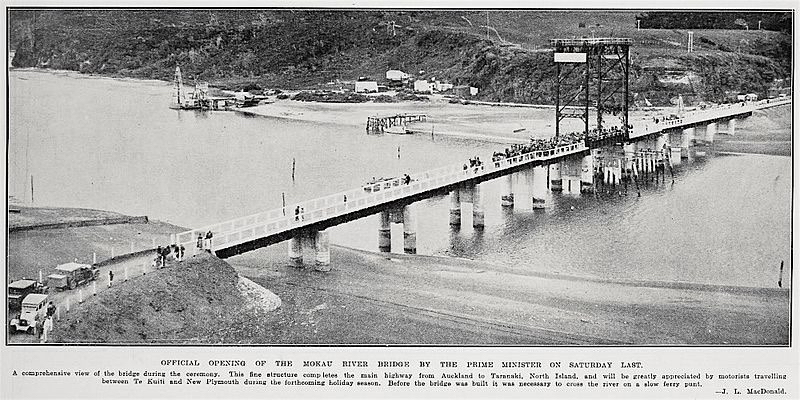Mōkau (Māori: Mōkau) is a small town on the west coast of New Zealand’s North Island, located at the mouth of the Mōkau River on the North Taranaki Bight.
Mōkau is in the Waitomo District and Waikato Region local government areas, just north of the boundary with the New Plymouth District and the Taranaki Region. State Highway 3 passes through the town on its route from Te Kuiti to Waitara and, eventually, New Plymouth.

The Mōkau River Bridge opened in 1927.
Today Mōkau is a popular location for whitebaiting and other fishing including for kahawai (mainly found at the river mouth) and snapper (which are found right along the coast in several spots).
Mōkau also has a couple of outstanding surf breaks that, in the right conditions, can produce waves of up to 6 ft (1.8m).
The Mōkau River is a feature of the area and enjoys a colourful and interesting history. The river for its whole length once formed the boundary between the Auckland and Taranaki Provinces, and today forms the boundary between the land districts.
The port, at the mouth of the river, is no longer used. At its mouth, the Mōkau River is confined by a sand bar, and on the raised beaches formed during the past, iron sand dunes have been deposited.
The river is tidal for some distance upstream. From near Piopio, the river enters a broadly open, low-rounded topography above the steep-walled, narrow limestone gorges.
Pre-European Times
In pre-European times the Mōkau River marked the boundary between the Tainui and Taranaki tribal areas; in particular, the territory was often under dispute between Ngati Maniapoto and Ngati Tama.
Although a small tribe, Ngati Tama, held their own against all comers until the early part of the nineteenth century when two battles altered the traditional power balance in the district. About 1815 there was a disastrous battle, Nga-tai-pari-rua, against Ngati Rakei on Mōkau beach. Read more about the 1815 battle here.
Six years later a strong Maniapoto war party, armed with muskets, invaded the district.
There was a fierce engagement at Pararewa in September 1821, when the Ngati Tama and Te Ati-awa were heavily defeated and Tupaki, the great Ngati Tama war chief, was killed. After this, the remnants of Ngati Tama joined Te Rauparaha’s trek south to Cook Strait.
Their departure left Taranaki open to the depredations of Te Wherowhero and his Waikato.
Check out the self-guided Mōkau Historical Township Walk below